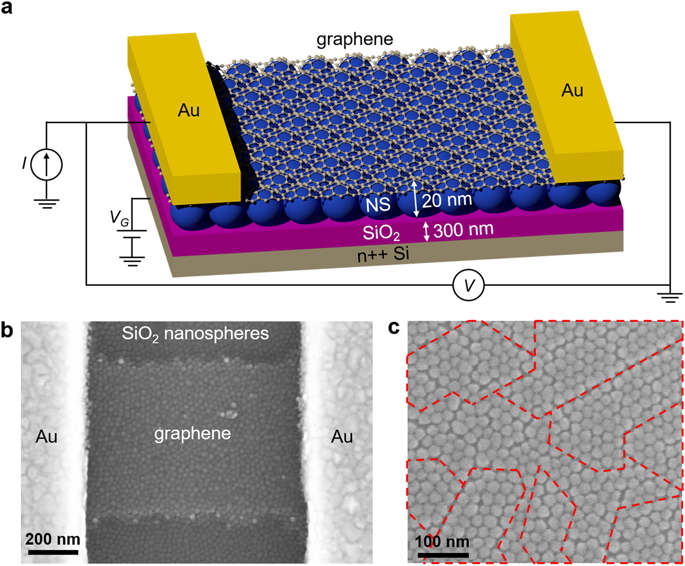npj 2D Materials and Applications ( IF 9.1 ) Pub Date : 2018-09-18 , DOI: 10.1038/s41699-018-0076-0 Yingjie Zhang , Youngseok Kim , Matthew J. Gilbert , Nadya Mason

|
Nanoscience offers a unique opportunity to design modern materials from the bottom up via low-cost, solution processed assembly of nanoscale building blocks. These systems promise electronic band structure engineering using not only the nanoscale structural modulation, but also the mesoscale spatial patterning, although experimental realization of the latter has been challenging. Here, we design and fabricate a new type of artificial solid by stacking graphene on a self-assembled, nearly periodic array of nanospheres, and experimentally observe superlattice miniband effects. We find conductance dips at commensurate fillings of charge carriers per superlattice unit cell, which are key features of minibands that are induced by the quasi-periodic deformation of the graphene lattice. These dips become stronger when the lattice strain is larger. Using a tight-binding model, we simulate the effect of lattice deformation as a parameter affecting the inter-atomic hopping integral, and confirm the superlattice transport behavior. This 2D material-nanoparticle heterostructure enables facile band structure engineering via self-assembly, promising for large-area electronics and optoelectronics applications.
中文翻译:

通过自组装纳米结构设计的二维超晶格中的电子传输
纳米科学提供了一个独特的机会,可以通过低成本,溶液处理的纳米级构造块的组装,从下至上设计现代材料。这些系统承诺不仅利用纳米尺度的结构调制,而且利用中尺度的空间构图进行电子能带结构工程,尽管后者的实验实现具有挑战性。在这里,我们通过将石墨烯堆叠在自组装的,近乎周期性的纳米球阵列上来设计和制造一种新型的人造固体,并通过实验观察超晶格的微带效应。我们在每个超晶格晶胞的相应电荷载流子填充处发现电导下降,这是由石墨烯晶格的准周期性变形引起的微带的关键特征。当晶格应变较大时,这些倾角变强。使用紧密绑定模型,我们模拟晶格变形的影响作为影响原子间跳变积分的参数,并确定超晶格的传输行为。这种2D材料-纳米粒子异质结构通过自组装实现了易带结构的工程设计,有望用于大面积电子学和光电学应用。











































 京公网安备 11010802027423号
京公网安备 11010802027423号